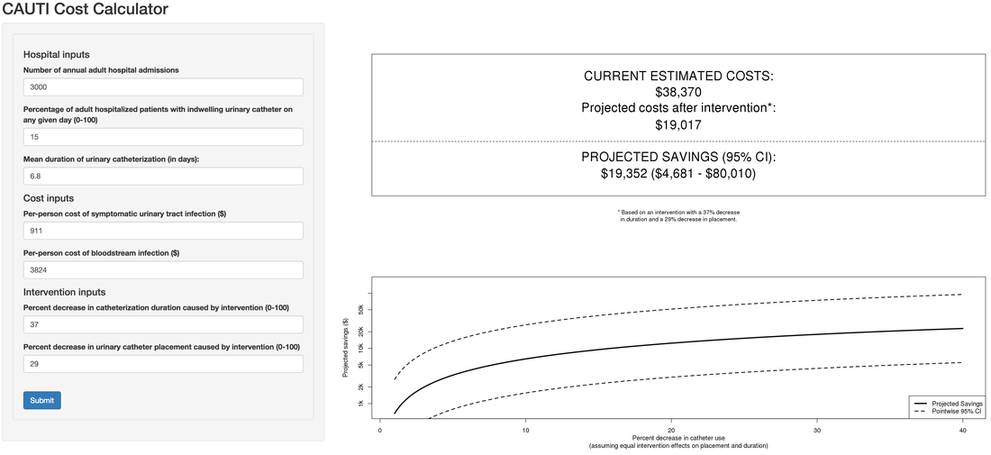The CAUTI Cost Calculator estimates your hospital's costs due to catheter-associated urinary tract infections (CAUTI), which are the most common form of hospital-acquired infection.
It can be used to estimate both current costs and projected costs after a hypothetical intervention to reduce catheter use, a protocol that involves daily assessment of the need for a catheter.
Click on the image below to begin...
It can be used to estimate both current costs and projected costs after a hypothetical intervention to reduce catheter use, a protocol that involves daily assessment of the need for a catheter.
Click on the image below to begin...
Some details:
The CAUTI cost calculator works by combining relevant risk and cost estimates from past research on catheter-associated complications.
Saint (2000) provides estimates of the risk of bacteriuria, symptomatic urinary tract infection (SUTI), and bloodstream infection (BSI), as well as estimates of the costs associated with SUTI and BSI, computed via microcosting techniques. We combine these estimates to produce new estimates of hospital-specific savings across a range of hypothetical interventions that reduce (i) the duration of catheterization and (ii) the proportion of patients with catheters. This dual-component characterization of interventions to reduce CAUTI is similar to that taken in Fakih et al. (2012).
We focus specifically on savings after the estimated reductions in duration from Meddings et al. (2010) and in placement from Fakih et al. (2010).
References:
The CAUTI cost calculator works by combining relevant risk and cost estimates from past research on catheter-associated complications.
Saint (2000) provides estimates of the risk of bacteriuria, symptomatic urinary tract infection (SUTI), and bloodstream infection (BSI), as well as estimates of the costs associated with SUTI and BSI, computed via microcosting techniques. We combine these estimates to produce new estimates of hospital-specific savings across a range of hypothetical interventions that reduce (i) the duration of catheterization and (ii) the proportion of patients with catheters. This dual-component characterization of interventions to reduce CAUTI is similar to that taken in Fakih et al. (2012).
We focus specifically on savings after the estimated reductions in duration from Meddings et al. (2010) and in placement from Fakih et al. (2010).
References:
Acknowledgments:
This calculator was developed by Edward Kennedy, MS, of the University of Michigan(UM)/Department of Veterans Affairs Patient Safety Enhancement Program. The web interface for the calculator was developed by Jeremy Hallum and Drew Montag of UM Medical School Information Systems.
This calculator was developed by Edward Kennedy, MS, of the University of Michigan(UM)/Department of Veterans Affairs Patient Safety Enhancement Program. The web interface for the calculator was developed by Jeremy Hallum and Drew Montag of UM Medical School Information Systems.


